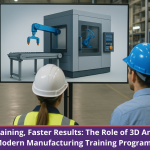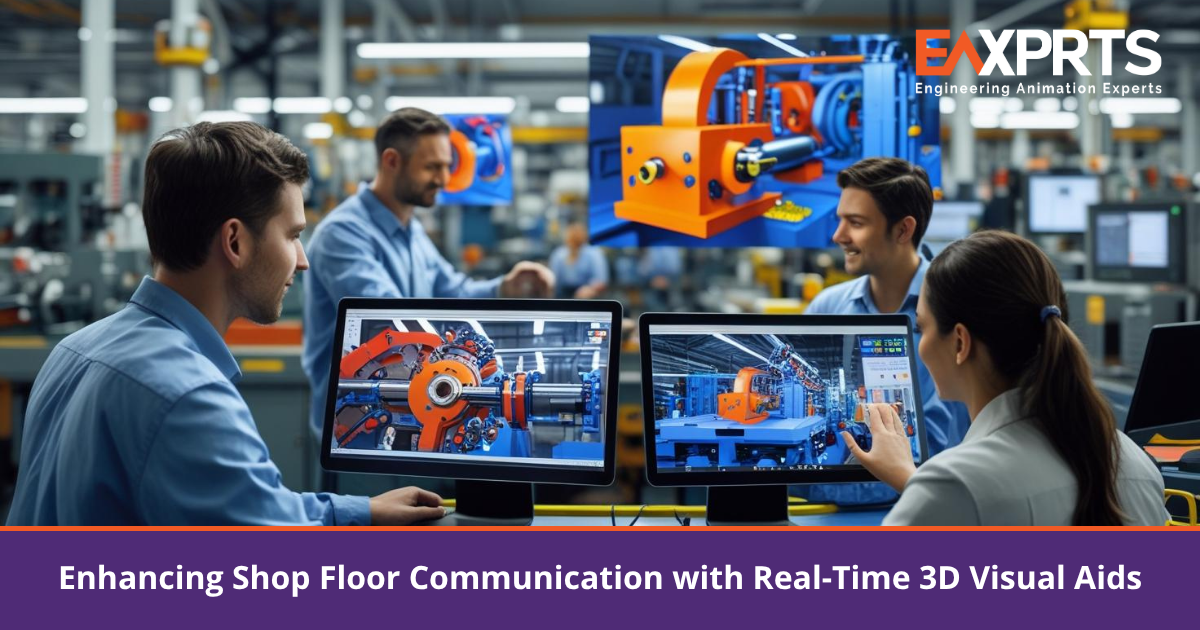
Seeing the Invisible: How Animation is Quietly Transforming the Pharmaceutical Industry
July 17, 2025
Smarter Training, Faster Results: The Role of 3D Animation in Modern Manufacturing Training Programs
August 26, 2025Enhancing Shop Floor Communication with Real-Time 3D Visual Aids
Effective communication on the shop floor is a cornerstone of manufacturing excellence. With operations becoming increasingly complex and fast-paced, relying solely on verbal instructions, printed SOPs, or static signage often leads to miscommunication, errors, and inefficiencies. This is where real-time 3D visual aids come into play, bridging information gaps with dynamic, intuitive, and visually rich content.
From production line guidance to equipment details, real-time 3D visual aids are revolutionizing how teams interact with systems and each other on the shop floor. These tools empower workers to make faster decisions, reduce mistakes, and improve overall productivity by presenting relevant data and instructions in a format that’s universally understandable.
What Is Real-Time 3D Visual Aids?
Real-time 3D visual aids are animated, interactive visual communication tools that deliver up-to-the-moment information using digital 3D models and animations. Unlike static instructions or traditional dashboards, these tools display dynamic visuals that can respond to user interactions.
Common formats include:
- Animated instructional displays at workstations
- Augmented Reality (AR) overlays showing part placement or component status
- WebXR visualizing machine performance with 3D elements
- Human-Machine Interfaces (HMIs) with integrated animated troubleshooting guides
By combining real-time data streams with 3D visualization, manufacturers can ensure that the right information reaches the right person at the right time visually, clearly, and in context.
Key Benefits of Real-Time 3D Visual Communication
- Bridging Language and Skill Gaps
Manufacturing workforces are often diverse, with varying levels of language proficiency and technical expertise. Real-time 3D animations transcend these barriers by showing instructions and processes in a universally understood format.
Whether it’s a new hire or a veteran worker transitioning to a new line, animated visual aids ensure clarity. For example, instead of reading a multi-step instruction, an operator can watch a real-time animation video that shows exactly how a part should be oriented and installed.
- Improved Accuracy and Speed
Static instructions are prone to interpretation errors. Real-time 3D aids eliminate ambiguity by providing animated, step-by-step guidance that is actual process conditions.
These visualizations help:
- Reduce assembly or handling errors
- Speed up decision-making by eliminating guesswork
- Provide validation if a step is skipped or performed incorrectly
- Streamlined Shift Handovers and Workflows
Miscommunication during shift transitions can lead to rework, downtime, or unsafe practices. With real-time dashboards that include 3D representations of machine, incoming teams get a complete visual summary of the state of operations.
Visual handovers improve continuity, allowing operators and supervisors to identify anomalies or priorities at a glance, instead of sifting through notes or spreadsheets.
- Safer Shop Floors
Real-time 3D animation videos enhance safety by animating alerts, emergency protocols, or lockout-tagout procedures. Instead of relying solely on flashing lights or buzzers, operators receive clear visual cues, such as a 3D animation showing which panel to isolate or which path to avoid during equipment movement.
This reduces the likelihood of human error in high-risk scenarios, supporting a stronger safety culture.
Real-Time 3D Applications on the Shop Floor
Here are some practical use cases where real-time 3D animation is transforming communication on the floor:
- Workstation Instructions: Monitors at assembly stations display animated procedures based on the specific product or variant being built.
- WebXR Devices: Operators using WebXR devices can view 3D animation visuals that guide them through maintenance, product understanding or verify part positioning.
- Smart Tools: Scanning a barcode or RFID tag triggers an on-screen animation that shows the next assembly step or torque specification.
- Troubleshooting Aids: Interactive 3D animations show probable causes and fixes for machine faults, guiding technicians without needing printed manuals.
These applications make information delivery faster, more engaging, and easier to follow in high-pressure environments.
Integration with Digital Manufacturing Systems
To be effective, real-time 3D animation visuals must be connected to digital manufacturing systems such as MES (Manufacturing Execution Systems), ERP, or IoT platforms. These integrations allow:
- Live data feeds to trigger context-aware visuals
- Centralized SOPs and BOMs to feed directly into visual instruction systems
- Sensor-based alerts to showcase pre-configured/ ready-made animated videos of equipment conditions (e.g., temperature spikes, cycle time delays)
For example, when a sensor detects a vibration anomaly in a motor, a nearby screen might instantly display a 3D animation of the correct inspection and lubrication steps, along with a severity level and estimated time to fix.
Case Study Examples / Success Scenarios
- Automotive Industry: A car manufacturer implemented animated work instructions at engine assembly lines. New operators reached full productivity 30% faster, and defect rates dropped significantly due to clearer visual guidance.
- FMCG Manufacturing: A facility producing packaged goods used animated SOPs in multiple languages for hygiene and safety training. Worker compliance improved, and cross-training time was cut in half.
Challenges and Considerations
While the benefits are compelling, successful implementation requires careful planning:
- Hardware Investment: Screens, tablets, or AR/VR devices must be rugged, ergonomic, and strategically placed.
- Content Management: 3D content must be kept current as processes evolve; outdated visuals can cause confusion.
- Connectivity and Reliability: Network stability is crucial for real-time updates; latency can degrade user trust and effectiveness.
Partnering with experienced 3D animation developers and teams ensures scalability and long-term success.
Future Trends
As technology matures, real-time 3D visual aids are expected to become smarter and more adaptive:
- AI-Driven Customization: Systems may tailor visuals based on worker experience, speed preferences, or past error rates.
- WebXR Immersion: Blending VR, MR, and AR will offer deeper interaction with virtual models and digital twins in real workspaces.
- Speech-Driven Interactions: Workers may soon ask for specific animations or instructions using voice commands.
These innovations will further elevate the role of 3D animation in enhancing shop floor communication and worker performance.
Conclusion
Clear, timely communication is critical on the manufacturing floor and real-time 3D visual aids offer a groundbreaking solution. By turning complex data and instructions into engaging, animated visuals, these tools enhance understanding, boost productivity, and support safer, more efficient operations.
As manufacturers continue to digitize, the use of real-time 3D visuals will become a standard practice in achieving operational excellence.
To explore how real-time 3D visual aids can improve communication in your operations, read our full pillar blog: The Role of 3D Engineering Animation in Modern Manufacturing: Design, Assembly & Maintenance.
Talk to us today! Reach us on sales@eaxprts.com



